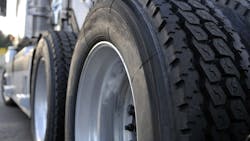Rohlwing: There's no substitute for natural tire rubber, so focus on conservation
While I may be a bit biased, modern radial truck tires and retreads are engineering marvels. When properly loaded and inflated, they perform in every environmental and operational condition with a minimal chance of failure. Compared to the 1980s, when I started as a tire tech, manufacturing technology has advanced at an incredible rate creating a more uniform and consistent product. And as technology continues to advance, future truck tires and retreads will only keep getting better.
The three foundational components of a truck tire are oil, natural rubber, and steel. According to the U.S. Tire Manufacturers Association (USTMA), a truck tire is made up of 11% synthetic polymers, 10% antioxidants/antiozonants, and 24% fillers. I’m not a chemist or a manufacturing engineer, but I’m willing to bet that a significant portion is petrochemical, so truck tires require crude oil as a raw material. That said, I also know that manufacturers continue to explore non-petrochemical alternatives to reduce the dependency on fossil fuels. Regardless, the reliance on oil will continue for some time.
See also: Rohlwing: What last-mile fleets need to know about tires
The USTMA lists steel as 21% of a radial truck tire, but it’s important to note that we are not talking about regular steel. The steel that is used for the beads, body ply, and belt package must possess the necessary properties to function inside the tire and bond with the rubber components. It must be incredibly strong yet flexible with resistance to extreme cold and heat. Manufacturers must maintain an exact degree of precision from raw materials to production in order to consistently supply the high-quality steel needed for truck tires, which means there are a limited number of them in the world.
The final component of a radial truck tire is extracted from trees, and without it, tire performance would be drastically changed. Natural rubber has properties that cannot currently be replicated with synthetic compounds. The rubber in tires must flex without tearing or cracking. It also must be strong enough to withstand the constant scrubbing and abrasion created by different road surfaces. Natural rubber is still the best raw material for those properties, and as I’ve been saying for years, tires are agricultural products.
Rohlwing: What trucking can learn about TPMS from the passenger experience
Like any agricultural product, natural rubber trees are subject to disease, drought, and other environmental factors. Unlike most agricultural products, natural rubber trees can survive and produce latex in a very limited number of environments. The Association of Natural Rubber Producing Countries (ANRPC) has 13 members in Southeast Asia that account for around 90% of global natural rubber production. Thailand is the leading producer followed by Indonesia. Together, those two nations represented about half of the world’s natural rubber production in June 2023.
During World War II, the U.S. experienced a firsthand account of what life was like without an ample supply of natural rubber from Southeast Asia. Rubber rationing reached the point where the government enacted a “Victory Speed” of 35 mph from May 1942 to August 1945 to reduce gasoline and rubber consumption. Without access to 90% of the world’s rubber supply, the government also ramped up efforts to produce synthetic rubber and, by the end of the war, the U.S. had spent as much money on the rubber program as it had on the atomic bomb. Military leaders knew we could not win the war without rubber.
Conservation was the national focus, and retreading played a major role in preserving this critical and strategic raw material. It continues to be an environmentally and economically sound approach to reducing the dependency on a commodity with a limited and possibly uncertain supply. Retreads still contain natural rubber, but the content and overall carbon footprint of a retread is less than it is for a new tire. And like new tire manufacturing, retread technology continues to improve and provide an unprecedented level of uniformity and consistency.
Even with natural rubber alternatives that can be grown domestically like guayule, the volume of latex needed in the tire industry continues to be reliant on a politically unstable region with unpredictable weather patterns and the constant threat of disease. Fleets need to focus on the conservation of every tire and retread on the ground to get the absolute most out of every wheel position. The tire shortage following the pandemic was just a taste of what could happen in a doomsday scenario. Failing to plan is planning to fail.
Kevin Rohlwing is the SVP of training for the Tire Industry Association. He has more than 40 years of experience in the tire industry and has created programs to help train more than 180,000 technicians.
About the Author
Kevin Rohlwing
Kevin Rohlwing is the SVP of training for the Tire Industry Association. He has more than 40 years of experience in the tire industry and has created programs to help train more than 180,000 technicians.
